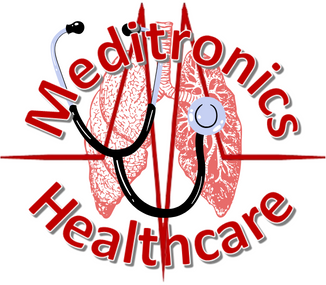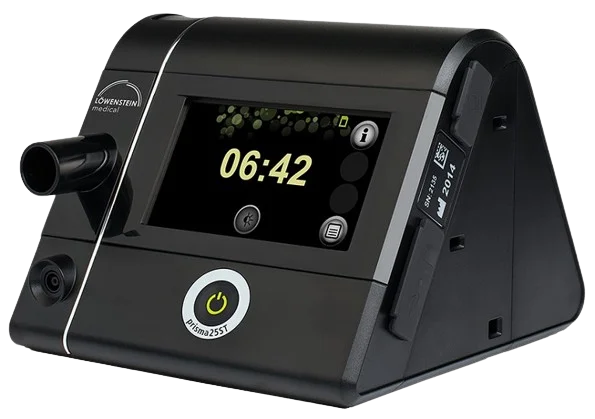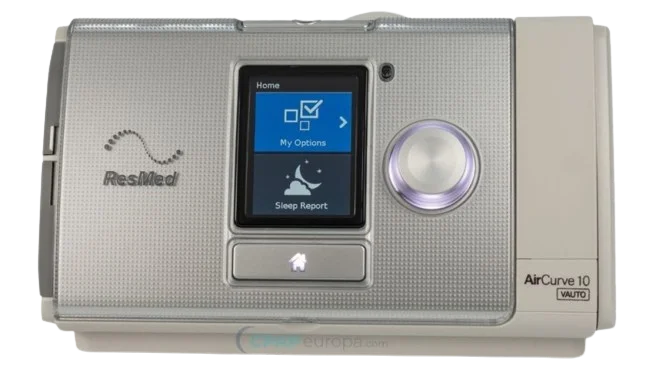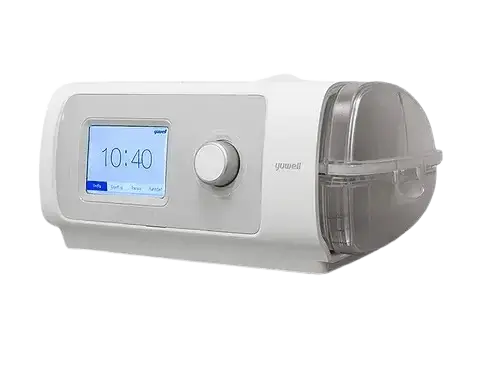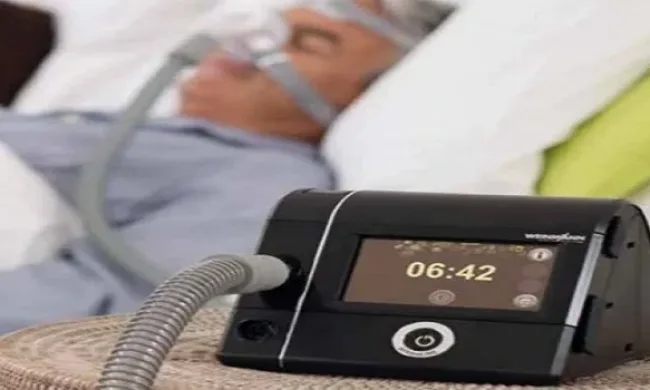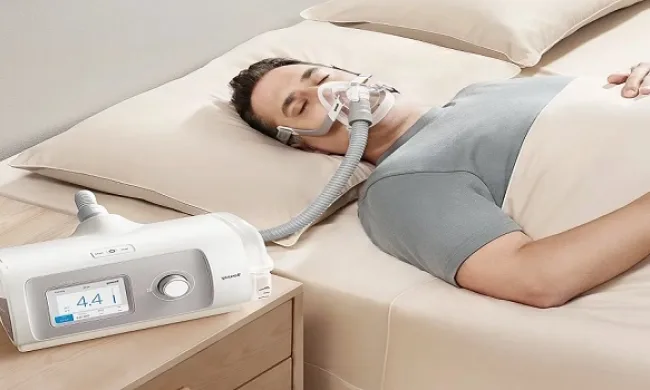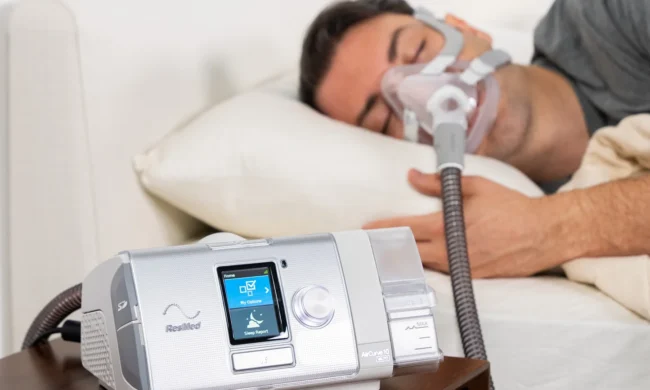What is BiPAP?
BiPAP , or Bilevel Positive Airway Pressure, is another type of positive airway pressure therapy device used to treat sleep-related breathing disorders, such as sleep apnea. It deliver pressurized air to keep the airway open during sleep, but they offer a unique advantage – two different pressure levels:
- IPAP (Inspiratory Positive Airway Pressure): Higher pressure when inhaling
- EPAP (Expiratory Positive Airway Pressure): Lower pressure when exhaling
This dual-pressure design allows for more natural breathing and is especially beneficial for individuals who find it difficult to exhale against the continuous pressure of a CPAP machine.
How Does BiPAP Work?
BiPAP therapy adapts to your breathing cycle. When you breathe in, the machine provides a higher pressure to support your lungs. As you breathe out, it reduces the pressure, making exhalation easier. This system ensures proper oxygen intake while reducing strain during breathing.
Unlike CPAP, which provides constant pressure, BiPAP offers greater flexibility, making it suitable for patients with higher pressure needs or certain respiratory conditions.
Who Needs BiPAP Therapy?
It is often recommended for:
- Individuals with obstructive or central sleep apnea.
- Patients with chronic obstructive pulmonary disease (COPD).
- People suffering from neuromuscular disorders affecting breathing.
- Patients requiring higher air pressure than CPAP can comfortably provide:
A doctor’s evaluation is important to determine whether BiPAP therapy is right for you.
Educational Video
🙏 Thank you for watching!
We hope you like the explanation of BiPAP Therapy Device.
Better Breathe... Sound Sleep!
📚 Explore Other Therapy Devices
Benefits of Bilevel Positive Airway Pressure Machines:
- Easier exhalation due to lower EPAP pressure.
- Greater comfort compared to constant CPAP pressure.
- Better sleep compliance because breathing feels more natural.
- Customized therapy settings for unique respiratory needs.
- Non-invasive support for patients with advanced breathing disorders.
Please click bilevel therapy machine if you would like to read our blog on this topic.
BiPAP vs CPAP:
Here’s a quick comparison to help you understand the difference:
Feature | CPAP | Bilevel Positive Airway Pressure |
Air Pressure | Constant, single pressure | Two levels: IPAP (inhale), EPAP (exhale) |
Comfort Level | May feel harder to exhale | Easier, more natural breathing |
Best For | Obstructive Sleep Apnea | Central Sleep Apnea, COPD, complex cases |
Pressure Settings | Fixed or auto-adjusting | Fully customizable |
Both devices are effective, but BiPAP is often chosen when CPAP is not sufficient or comfortable.
Tips for Using a BiPAP Machine:
- Use your sleep therapy device every night – consistency is key for results.
- Clean mask and tubing regularly – prevents bacteria buildup.
- Replace filters as recommended – ensures fresh airflow.
- Adjust mask fit for comfort – prevents air leaks.
- Work with your doctor – to fine-tune IPAP/EPAP settings.
FAQs About BiPAP Machines:
What is the difference between CPAP and BiPAP?
Continuous Positive Airway Pressure (CPAP) delivers one continuous pressure, while Bilevel Postive Airway Pressure delivers two levels – one for inhalation and one for exhalation.
Can BiPAP treat central sleep apnea?
Yes, it is often prescribed for central sleep apnea, complex sleep apnea, and other advanced respiratory conditions.
Is BiPAP therapy safe for home use?
Absolutely. With proper medical guidance, Bilevel Positive Airway Pressure devices are safe and effective for home therapy.
Do I need a prescription for BiPAP?
Yes, prescription is needed and should be customized to your condition by a healthcare professional.
Who needs a BiPAP machine instead of CPAP?
It is usually recommended for people who struggle to exhale against CPAP pressure, or for those with central sleep apnea, COPD, or other complex respiratory conditions.
Can BiPAP machines be used at home?
Yes. Most these are designed for home use and are easy to set up. Your healthcare provider will guide you on pressure settings and proper usage.
Is BiPAP therapy covered by insurance?
In many cases, it is covered if prescribed by a doctor for medical necessity. It’s best to check with your healthcare provider and insurance company.
How long should I use my BiPAP machine each night?
You should use every night during sleep, ideally for the full duration of your rest. Consistent use ensures better symptom control and improved sleep quality.
Does BiPAP therapy have side effects?
Some users may experience dry mouth, nasal congestion, or mild discomfort at first. These issues are often resolved with humidifiers, mask adjustments, or gradual acclimatization.
How do I maintain my BiPAP machine?
Regular cleaning of the mask, tubing, and humidifier chamber is essential. Filters should be checked and replaced as recommended by the manufacturer.
Usage Tips & Maintenance:
For best results, wear your sleep therapy device during every sleep period, including naps. Consistency improves your health and sleep quality.
Wipe your mask cushion with a soft, damp cloth or mild soap to remove oils and maintain a good seal.
Use warm water and mild detergent to clean the tubing and water chamber. Let them air-dry completely before reassembly.
BiPAP machines use disposable and reusable filters. Check them weekly and replace per the manufacturer’s instructions.
A loose mask may leak air, while an overly tight mask can cause discomfort. Adjust straps for a comfortable, secure fit.
Always fill the humidifier with distilled water to prevent mineral buildup and extend device life.
Consult your doctor to review BiPAP settings and therapy progress, especially if symptoms persist
